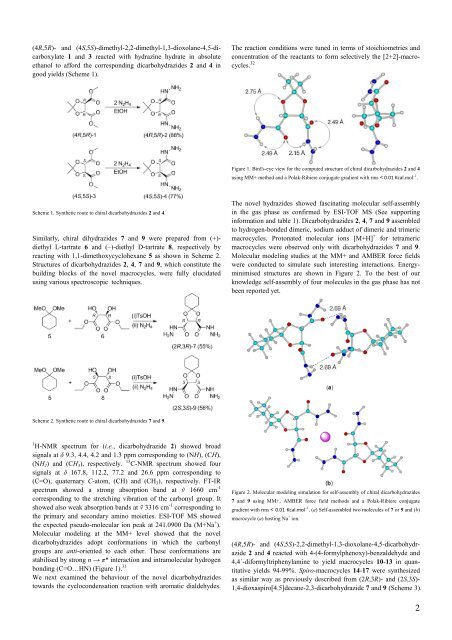The Development of Novel Antibiotics Using ... - Jacobs University
The Development of Novel Antibiotics Using ... - Jacobs University
The Development of Novel Antibiotics Using ... - Jacobs University
Create successful ePaper yourself
Turn your PDF publications into a flip-book with our unique Google optimized e-Paper software.
(4R,5R)- and (4S,5S)-dimethyl-2,2-dimethyl-1,3-dioxolane-4,5-dicarboxylate<br />
1 and 3 reacted with hydrazine hydrate in absolute<br />
ethanol to afford the corresponding dicarbohydrazides 2 and 4 in<br />
good yields (Scheme 1).<br />
<strong>The</strong> reaction conditions were tuned in terms <strong>of</strong> stoichiometries and<br />
concentration <strong>of</strong> the reactants to form selectively the [2+2]-macrocycles.<br />
32<br />
Figure 1. Bird's-eye view for the computed structure <strong>of</strong> chiral dicarbohydrazides 2 and 4<br />
using MM+ method and a Polak-Ribiere conjugate gradient with rms ˂ 0.01 Kcal.mol –1 .<br />
Scheme 1. Synthetic route to chiral dicarbohydrazides 2 and 4.<br />
Similarly, chiral dihydrazides 7 and 9 were prepared from (+)-<br />
diethyl L-tartrate 6 and (–)-diethyl D-tartrate 8, respectively by<br />
reacting with 1,1-dimethoxycyclohexane 5 as shown in Scheme 2.<br />
Structures <strong>of</strong> dicarbohydrazides 2, 4, 7 and 9, which constitute the<br />
building blocks <strong>of</strong> the novel macrocycles, were fully elucidated<br />
using various spectroscopic techniques.<br />
<strong>The</strong> novel hydrazides showed fascinating molecular self-assembly<br />
in the gas phase as confirmed by ESI-TOF MS (See supporting<br />
information and table 1). Dicarbohydrazides 2, 4, 7 and 9 assembled<br />
to hydrogen-bonded dimeric, sodium adduct <strong>of</strong> dimeric and trimeric<br />
macrocycles. Protonated molecular ions [M+H] + for tetrameric<br />
macrocycles were observed only with dicarbohydrazides 7 and 9.<br />
Molecular modeling studies at the MM+ and AMBER force fields<br />
were conducted to simulate such interesting interactions. Energyminimised<br />
structures are shown in Figure 2. To the best <strong>of</strong> our<br />
knowledge self-assembly <strong>of</strong> four molecules in the gas phase has not<br />
been reported yet.<br />
Scheme 2. Synthetic route to chiral dicarbohydrazides 7 and 9.<br />
1 H-NMR spectrum for (i.e., dicarbohydrazide 2) showed broad<br />
signals at δ 9.3, 4.4, 4.2 and 1.3 ppm corresponding to (NH), (CH),<br />
(NH 2 ) and (CH 3 ), respectively. 13 C-NMR spectrum showed four<br />
signals at δ 167.8, 112.2, 77.2 and 26.6 ppm corresponding to<br />
(C=O), quaternary C-atom, (CH) and (CH 3 ), respectively. FT-IR<br />
spectrum showed a strong absorption band at ṽ 1660 cm -1<br />
corresponding to the stretching vibration <strong>of</strong> the carbonyl group. It<br />
showed also weak absorption bands at ṽ 3316 cm -1 corresponding to<br />
the primary and secondary amino moieties. ESI-TOF MS showed<br />
the expected pseudo-molecular ion peak at 241.0900 Da (M+Na + ).<br />
Molecular modeling at the MM+ level showed that the novel<br />
dicarbohydrazides adopt conformations in which the carbonyl<br />
groups are anti-oriented to each other. <strong>The</strong>se conformations are<br />
stabilised by strong n → π* interaction and intramolecular hydrogen<br />
bonding (C=O…HN) (Figure 1). 31<br />
We next examined the behaviour <strong>of</strong> the novel dicarbohydrazides<br />
towards the cyclocondensation reaction with aromatic dialdehydes.<br />
Figure 2. Molecular modeling simulation for self-assembly <strong>of</strong> chiral dicarbohydrazides<br />
7 and 9 using MM+, AMBER force field methods and a Polak-Ribiere conjugate<br />
gradient with rms ˂ 0.01 Kcal.mol –1 . (a) Self-assembled two molecules <strong>of</strong> 7 or 9 and (b)<br />
macrocycle (a) hosting Na + ion.<br />
(4R,5R)- and (4S,5S)-2,2-dimethyl-1,3-dioxolane-4,5-dicarbohydrazide<br />
2 and 4 reacted with 4-(4-formylphenoxy)-benzaldehyde and<br />
4,4ʹ-diformyltriphenylamine to yield macrocycles 10-13 in quantitative<br />
yields 94-99%. Spiro-macrocycles 14-17 were synthesized<br />
as similar way as previously described from (2R,3R)- and (2S,3S)-<br />
1,4-dioxaspiro[4.5]decane-2,3-dicarbohydrazide 7 and 9 (Scheme 3).<br />
2

















